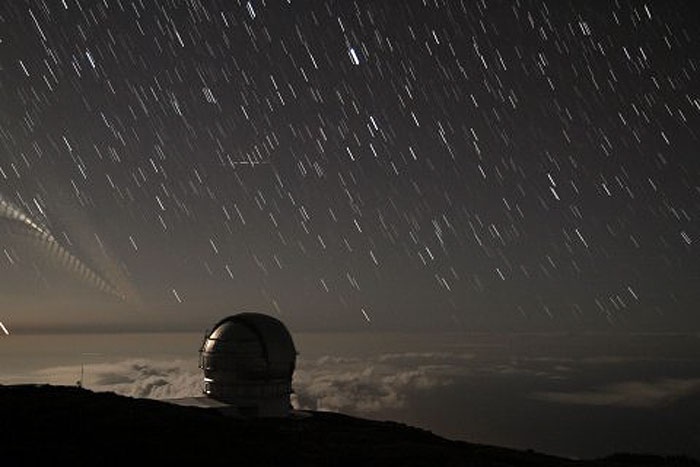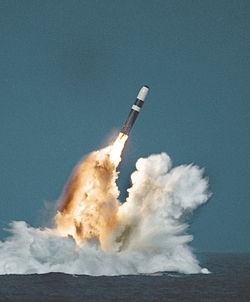.
...und es hat mich nicht mitgenommen. Schade. Egal, spannend ist allemal, was wir bei unserem kürzlichen La-Palma-Aufenthalt aufgenommen haben. Eigentlich wollten wir das größte optische Teleskop der Welt, das GranTeCan, bei der Arbeit filmen. Das ist auch gelungen, doch beim Zusammensetzen des Zeitraffers fiel mir ein ziemlich merkwürdiges Objekt auf. Hier die entscheidende Stelle:
.
21.09.2013
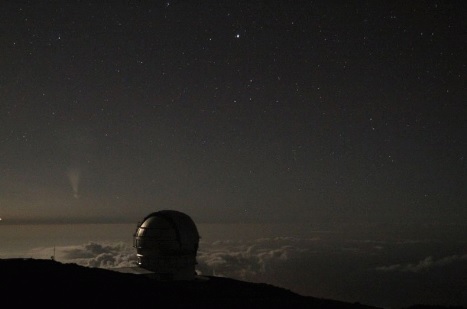
.
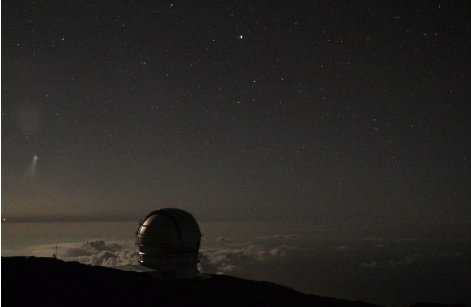
Frams aus Zeitraffer-Aufnahme:Jan Hattenbach
.
UPDATE, 21-09.: Marco Langbroek hat in einer sehr ausführlichen Analyse dargelegt, dass eigentlich nur ein geheimer Raketenstart einer ballistischen Rakete von einem UBoot im Atlantik als Erklärung in Frage kommt. Die Helligkeitsschwankungen des Objekts deutet er als Zündungen mehrere Raketenstufen, höchstwahrscheinlich einer militärischen Trident Rakete, die von US-amerikanischen und britischen UBooten eingesetzt werden.
Hier noch ein Stack des unten gezeigten Videos, der die Flugbahn des Objekts besser zeigt:
.
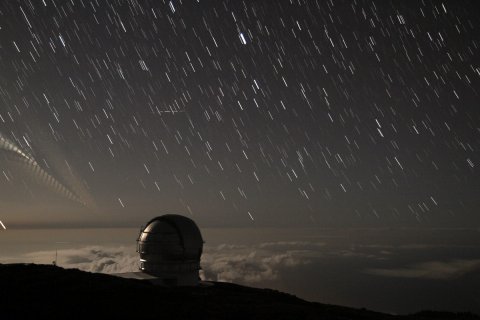
Aufnahmedatum war der 10. September 2013, dargestellt sind 42 Einzelbilder mit je 5 Sekunden Belichtungszeit und 2 Sekunden Pause dazwischen, die zwischen 21:16 und 21:20 Uhr Ortszeit (23:16-23:20 MESZ) aufgenommen worden sind. Die Position der Kamera war direkt oberhalb des GranTeCan-Teleskops, in 2300m Höhe mit Blickrichtung West (Westen liegt genau in Richtung Kuppel), die geografische Koordinaten sind laut Google Earth 28°45'23,04"N und 17°53'20,06"W).
Das Objekt am linken Bildrand sieht verdächtig nach einer startenden Rakete aus, der "Nebel" könnten Abgase oder auch abgelassener Treibstoff sein - so etwas kann man hin und wieder am Himmel sehen.
.
"Ufo-Alarm"? - Ein Raketenexperiment macht Wirbel
Für Aufregung sorgte gestern abend ein ungewöhnliches Himmelsereignis: Gegen 21:20 MESZ beobachteten zahllose Menschen mehrere seltsam leuchtende Wolken, die sich innerhalb weniger Minuten am Himmel ausbreiteten. Viele mutmaßten, es könne sich um helle Meteore, einen Kometen, Weltraumschrott oder gar um Ufos handeln - doch die richtige Erklärung ist eine andere!
Die ersten Beobachtungmeldungen gingen bereits wenige Minuten später in diversen Internetforen ein. Recht ähnlich lauten die Beschreibungen der Augenzeugen: Gegen 21:20 Uhr MESZ erschien demnach zunächst ein leuchtender Lichtpunkt am westlichen Himmel, der sich mit der typischen Geschwindigkeit eines erdnahen Satelliten Richtung Norden bewegte. Kurz dahinter zeigte sich eine "neblige Struktur", die manche Beobachter als ein "verglühendes Teil" interpretierten. Hinter diesem wiederum tauchte eine weitere neblige, als trichterförmig oder auch "kometenartig" beschriebene Struktur, die der ersten in einem Abstand von mindestens 30° folgte.
Besonders beindruckend aber war wohl eine gewaltige, haloartige Wolkenerscheinung, die die kometenförmige Struktur umgab und den Berichten zufolge fast die Hälfte des Himmels bedeckte. Die Erscheinung dauerte nicht sehr lange - nach etwa 15 Minuten verblassten die Wolken und lösten sich auf, während sie zum Nordhorizont wanderten.
Berichte zu diesem ungewöhnlichen Phänomen gibt es u. a. im Astrotreff-Forum, bei astronomie.de und natürlich im Forum des Arbeitskreises Meteore e. V. Hier, im meteoros-Forum, tauchten schon bald die ersten Bilder der Erscheinung auf. Besonders die hier gezeigte Bildserie illustriert das Phänomen sehr deutlich. (Edit: Diese hier auch - Gif-Animation ganz unten auf der Seite!)
Die Augenzeugenberichte und Fotos machten schnell deutlich, dass es sich weder um einen hellen Meteor (wie erst kürzlich mehrfach beobachtet) noch um einen Kometen handeln kann. Meteore sind verglühende Staubkörnchen in der Erdatmosphäre, die als Sternschnuppe kurzzeitig aufleuchten. Selbst wenn größere Brocken auf die Lufthülle der Erde treffen, so ist die Leuchterscheinung zwar viel beeindruckender (man spricht von Boliden oder Feuerkugeln), die Erscheinung ist aber in wenigen Sekunden vorüber.
Ein Komet ist ein meist kilometergroßer Eis-und Felsbrocken, der das Sonnensystem durchquert und in der Nähe der Sonne "aufschmilzt" und als Schweifstern sichtbar wird. Obwohl Kometen relativ unvermutet auftreten können, tauchen sie dennoch nicht aus dem Nichts auf. Sie werden oft schon Monate oder Jahre vor ihrem Erscheinen am irdischen Nachthimmel entdeckt. Auch befinden sie sich weit von der Erde weg - viele Millionen Kilometer - so dass ihre Bewegung sehr langsam im Vergleich zu einem Meteor (der sich ja nur wenige Kilometer über und befindet) erscheint. Kometen sind meist tage- oder wochenlang zu sehen, also wesentlich länger als die Erscheinung von gestern abend.
Die Erklärung ist profaner: Am 18. Oktober um 18:12 MESZ hob von einer Militärbasis in Kalifornien eine Atlas-V-Rakete mit einem militärischen Wettersatelliten (DMSP F18) ab. Es handelte sich übrigens um den 600. Start einer Atlas-Rakete, einem "Arbeitspferd" der US-amerikanischen Raumfahrt. Nachdem die Rakete ihre Nutzlast in einen polaren Orbit verbracht hatte, blieb noch genügend Treibstoff an Bord, um einige weitere Test mit der verbleibenden Centaur-Raketenstufe durchzuführen.
Der Höhepunkt dieser Experimente war ein letztes Zünden der Triebwerke, ziemlich genau drei Stunden nach dem Start - also zeitgleich mit dem Auftreten des Himmelsphänomens. Des Rätsels Lösung wurde ebenfalls schon kurz nach dem Eintreffen der ersten Meldungen über das Internet verbreitet: Es handelte sich bei den beobachteten Wolken um Raketenabgase von verbranntem Hydrazin, die freigesetzt wurden, als die Triebwerke noch einmal für 3 Minuten und 40 Sekunden eingeschaltet wurden und die Rakete von der Erde fort beschleunigten.
Edit: Auf dieser Karte der Raketenflugbahn (Quelle: United Launch Alliance) erkennt man deutlich, dass das Zünden des Triebwerks ("Disposal Burn", grüne Markierung) über Nordafrika startete und über Frankreich endete. Somit befand sich Westeuropa tatsächlich in einer Logenposition für die Beobachtung!
Ein solches Manöver ist in der Tat ungewöhnlich. Häufig werden die ausgebrannten Raketenstufen zum kontrollierten Absturz in den Pazifik gelenkt. Dieses Mal wollten die Raumfahrtingenieure aber das Experiment am Himmel mitverfolgen, weswegen sie die Rakete immer höher steigen ließen und so für ein abendliches Spektakel sorgten. Schade nur, dass es keine Ankündigung gab. Ich hätte mich sonst mit meiner Kamera in Position gestellt...
.
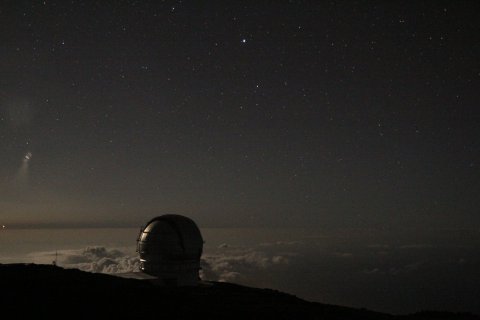
Einzelbild aus dem Video. Es scheint, als würde Gas oder eine Flüssigkeit von einer Rakete ausgestoßen - oder werden hier Booster abgesprengt? (Bild: Georg Görgen)
Problem nur: Es gab am 10. September keine Raketenstarts. Zumindest keine offiziellen, und auch keine "geheimen". Geheim in dem Sinne, dass sie zwar nicht offiziell angekündigt sind, aber für spezialisierte Amateure durchaus nicht unbekannt sind (mit einem solchen Fall hatten wir es in diesem Blog schon einmal zu tun). Nachdem ich den Videoclip via Meteoros-Forum und Twitter in die Welt gesetzt hatte, machten sich auch gleich einige Experten daran, die Bahn des unbekannten Flugobjekts zu bestimmen und es zu identifizieren.
Bislang ohne entscheidenen Erfolg. Vielleicht hat ja ein aufmerksamer Blogleser eine Idee?
Zwei wichtige Fragen sind bereits abgeklopft:
Stimmen Datum und Zeit? Ja, nach mehrfacher Überprüfung ist sicher, dass es defiitiv der 10. September war. Unser Rückflug war ein Tag später, also am 11. September. Wer an diesem Tag fliegt, vergisst das Datum nicht so schnell. Auch die Zeit stimmt: Zwar ging die Kamerauhr um genau 6 Minuten und 17 Sekunden vor, aber dieser Fehler ist in den obigen Zeiten bereits korrigiert. Außerdem ist im Video ein zweiter, "normaler" Satellit zu sehen, der von zwei Experten unabhängig voneinander als Cosmos 1410 identifiziert wurde. Schließlich ist am linken unteren Bildrand knapp die untergehende Venus zu sehen. Deren Untergang berechnet calsky.com für La Palma am 10. September 2013 für 21:16 Uhr Ortszeit. Berücksichtigt man die Kimmtiefe von 1,5° auf 2300m Seehöhe, dann dürfte sich der Untergang um wenige Minuten verzögern, eben auf den Zeitraum des Videos: 21:16-21:20 Ortszeit.
Handelt es sich um einen Kamerareflex? Unwahrscheinlich, schon vom Aussehen des Objekts zu urteilen. Überzeugt, dass es definitiv ein Objekt am Himmel war, bin ich aber aus folgendem Grund: Zwar haben wir in den entscheidenen Minuten eine Kaffeepause in der Residencia des Observatorio del Roque de los Muchachos gemacht, das eigentliche Ereignis also verpasst. Beim Hinausgehen erinnere mich aber an diese seltsame, vertikale "Wolke" am ansonsten völlig klaren Westhimmel. Wir unterhielten uns noch darüber und meinten, dass könne der persistent train einer Feuerkugel sein, und mit ein bisschen Glück sollten wir sie auf dem Film haben. Ich hatte diesen Vorfall schon wieder vergessen. Bis heute.
Halten wir also fest: Es handelt sich sicher um ein reales Himmelsobjekt, und auch Zeit und Datum sind bis auf eine geringe Unsicherheit bekannt. Was aber war es - wenn nicht ein Raketenstart? Bislang zeichnen sich vier Erklärungsmöglichkeiten ab:
Es war nicht nur ein geheimer, sonder ein sehr geheimer Start, von dem auch Satellitenbeobachter nicht wussten.
Es handelt sich um eine alte Raketenstufe, über die ebenfalls keine Daten von der US-Regierung veröffentlicht sind. Nach der Aussage eines Experten ist das möglich, es gibt wohl etliche Objekte, die dem Space-Debris-Tracking engehen. Dass ein solches Stück Weltraumschrott allerdings größere Mengen Treibstoff ablässt (wie soll sich sonst der "Nebel" erklären), kommt mir reichlich unwahrscheinlich vor.
Es war ein bekanntes Stück Weltraumschrott. Tatsächlich bewegte sich wenige Minuten später eine alte Atlas Centaur Raketenstufe in der gleichen Himmelsgegend. Die aber ist 50 Jahre alt und sollte keinen Treibstoff mehr enthalten, außerdem stimmen Bahn und Zeit eben doch nicht mit dem Video überein.
Satellitenexperte Marco Langbroek konnte bislang kein Objekt in den offiziellen NORAD-Katalogen und den inoffiziellen Amateurkatalogen finden, das mit "meinem" UFO übereinstimmen könnte. Am wahrscheinlichsten erscheint daher derzeit ein geheimer, suborbitaler ballistischer Raketenstart. Es braucht nicht viel Phantasie, dass dafür aller Wahrscheinlichkeit das US-Militär verantwortlich zeichnet, das jedenfalls legt schon die Flugbahn nahe. Ein Startpunkt in Florida oder einem anderen Ort in den Vereinigten Staaten ist wahrscheinlich.
Aber auch das ist bislang Spekulation. In jedem Fall ein interessanter Fund auf unseren "Urlaubsfotos"!
.
Quelle: Mit freundlicher Genehmigung: Jan Hattenbach, http://www.scilogs.de/kosmo/blog/himmelslichter/content/about
.

In the evening of September 10, 2013, German astrophotographer Jan Hattenbach was taking images with an f2.8/24mm lens near the GranTeCa dome, at 2300 meter altitude at the Roque de los Muchachos observatory on La Palma in the Canary Islands. His camera was looking due west, out over the Atlantic Ocean, in the direction of Bootes and Virgo. The intention was to create a time lapse movie.
Between 21:16 and 21:20 UT, he captured something unexpected on his images. A strange fuzzy bright object moved over the images, spouting cloudy puffs. Above is a stack of the images: it shows the GranTeCa dome, star trails, a normal satellite (Kosmos 1410)...and the strange cloudy phenomena coming under an oblique angle from the horizon. Below is a short movie made from the images (5 second images with a 2 second interval). Note that it is a time-lapse that speeds up the event: the whole phenomena took about 2.5 minutes in real time:
Jan wrote about his strange observation on his own blog (in German) and posted his story on the AKM forum and on Twitter. Rainer Kresken forwarded it to the SeeSat-L mailinglist, and science writer/journalist Daniel Fischer tweeted to Jonathan McDowell and me whether we could explain the phenomena. Next, Jan was so kind to make his original imagery available to me.
Initially Jan reported that the images were taken near 21:23 UT (Sept 10, 2013). However, it turned out that his camera clock was off by several minutes. The event in reality happened earlier.
Luckily, a "normal" satellite is visible in the image sequence too, briefly flaring, and Cees Bassa and me could identify that satellite as Kosmos 1410 (82-096A). As the orbit of this object is known, astrometry I performed on the trail yielded the correct image times. Jan's camera clock was off by 6m 17s, as it turned out. The phenomena took place between 21:16 and 21:20 UT.
After seeing the images, my first thought was that this could be a fuel vent by a rocket booster in Earth orbit. The time and trajectory did however not match any known object, unclassified or classified.
Another option was a satellite launch. There were however no launches scheduled for this date (and this includes launches of classified objects, which you really cannot keep secret. They are publicly announced as it involves temporary restrictions to airspace down te launch trajectory, and a very visible rocket ascent from Vandenberg or Canaveral).
At that point, I started to suspect that it could perhaps be a hush-hush suborbital ballistic missile launch test, similar to the September 2, 2013, US-Israeli missile test in the Mediterranean. Harvard space historian Jonathan McDowell communicated a similar suspicion, noting that the particular part of the Atlantic has seen Poseidon SLBM tests in the past.
The thing is, that no such test was announced for this date. For example, I have found no NOTAM's restricting airspace over parts of the Atlantic because of a missile launch. That does not mean it is not a missile test though. It just means that whoever did the test, doesn't want to acknowledge it and preferred no-one to know about it. The September 2, US-Israeli test in the Mediterranean was not announced either (it came to light because it was detected by a Russian Early Warning Radar).
If the event seen from La Palma was indeed a clandestine Medium Range Ballistic Missile test (such as I believe is the case), the primary suspects are the Unites States or Great Britain, who both operate the Trident Submarine Launched Ballistic Missile (SLBM); or the French, who operate the M45 and M51 SLBM.
Several points in the observation fit a SLBM test. The US/British Trident and the French M45/M51 are 3-stage missiles. In the stacked image and movie above, there are two sudden bursts of brightness in the trail, both accompanied by an expanding puffy cloud. I interpret these as the moments of jettison of the 1st stage and ignition of the 2nd stage; and ejection of the 2nd stage and ignition of the 3rd stage. I have marked these moments, taking place at 21:17:08 and 21:18:43 UT (so with a 1m 35s separation), in below detail of the stacked image. The corresponding astrometric positions of these points are RA 205.061, Dec -3.950, and RA 211.366, Dec -6.153 degrees.
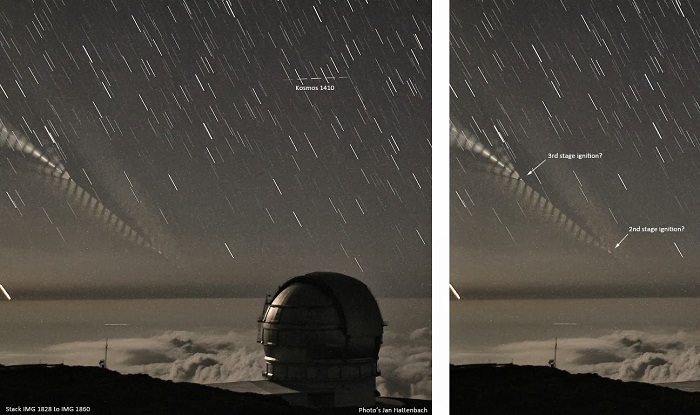
Below are details from the single still images from those moments:
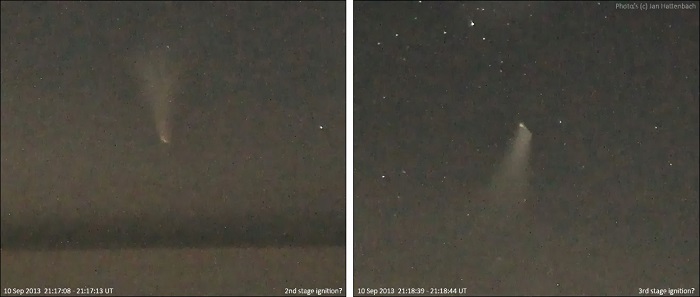
Below is a detail from a single frame just after what I interpret as the 3rd stage ignition, showing a bright fuzzy trail and expanding vapour clouds on both sides:
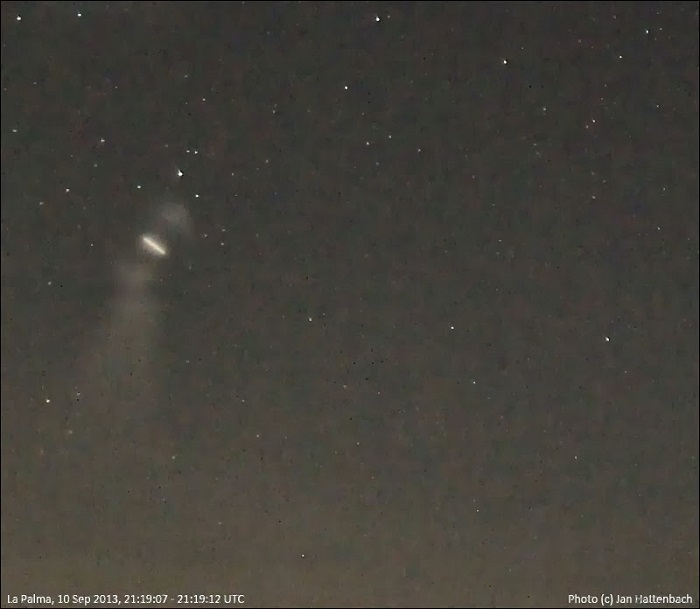
The duration of the event fits what is known of the Trident missile: from launch to 3rd stage ignition takes less than 2 minutes with the Trident. The 2nd stage ignites at about 70 km altitude, the 3rd at about 150km altitude.
A careful look at the stacked image shows that after what I interpret as the 3rd stage ignition, the trajectory clearly starts to deviate from the previous more or less straight line:
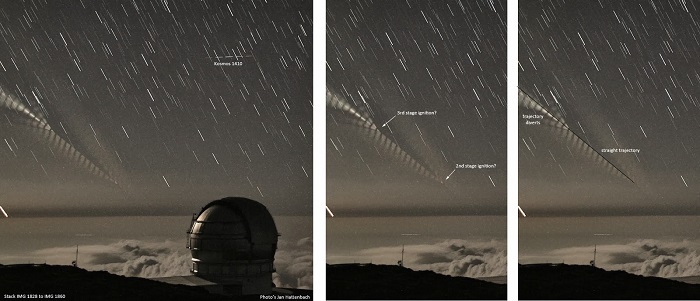
This is not an effect of lens distortion, as I will show below. It is a real deviation, that fits a missile launch. It shows unequivocally that the phenomena is not a fuel vent by a rocket booster in earth orbit. Such an object (moving in a Great Circle) would move in a straight line when positions are plotted in a Gnomonic projection. I did this for Jan's object: I astrometrically measured points on the trail and converted and plotted the measured RA/DEC in a gnomonic projection system. The same deviation that should not be there if this was an object in Earth orbit is visible in the RA/DEC data:
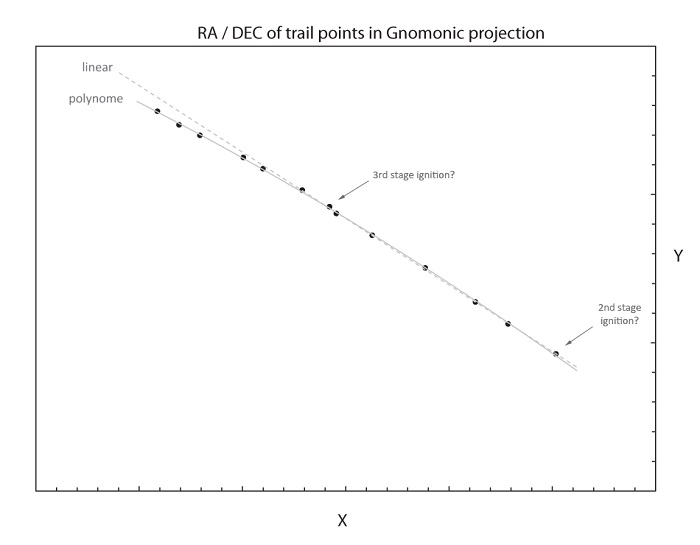
This makes very clear that Jan's object was not in orbit around the earth, but on a launch/ballistic trajectory. So we can definitely exclude a rocket booster orbiting the earth from a previous launch and venting fuel.
Just to support my previous argument further: here is what the trajectory in RA/DEC looks like for an object in an eccentric GTO orbit observed near perigee over a similar time span as Jan's object. The comparison object is the USA 40 rocket (1989-061D):
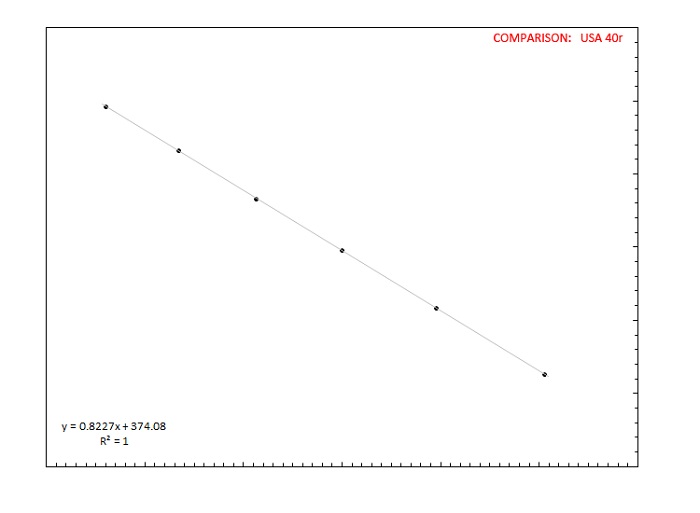
Assuming the La Palma event indeed was an unacknowledged Trident SLBM test by the USA or the British, the known specs of the Trident provide a (very) rough indication of where the launch took place.
As mentioned earlier, the 2nd stage of a Trident SLBM ignites at about 70 km altitude, the 3rd at about 150km altitude. As mentioned too above, I interpret two points in the trail to represent these moments. By measuring their astrometric position and calculating the corresponding azimuth and elevation in the sky, we can get a rough indication of distance and direction at these moments. I did this as a (please note) very rough back-of-the-envelope calculation. It suggests the launch took place near latitude 23-25N and a longitude several degrees West of 40 W. This is right in the middle of the Atlantic, at least 2000-3000 km from any coast in any direction. Again, that points to a Submarine launched missile. The launch azimuth is roughly 80-85 degrees, towards the African coast at a distance of over 3000 km.
The USA was testing missile intercepts near Kwajalein in the Pacific that same September 10. It is however highly unlikely that the launch that Jan seems to have captured is directly related, for the simple reason that a Trident launched in the Mid-Atlantic does not have the necessary reach to get to Kwajalein.
It is a busy time with missile tests: after the September 2 test in the Mediterranean, the September 10 tests near Kwajalein, and this potential unacknowledged test captured by Jan Hattenbach that same date, there was also a missile test in New Mexico on September 13. The Kwajalein tests were scheduled well before, but the unannounced September 2 test in the Mediterranean and perhaps also this unacknowledged September 10 test in the Atlantic might be part of ad hoc military practise exercises in connection to the continuing situation with Syria.
One question some might raise: why a Medium range Ballistic Missile launch? Why can't this not be an unacknowledged launch into Earth orbit? First: it would not be possible to keep such a launch from a US landbased site a secret. It would be seen over a wide area (like the New Mexico test) and necessitate temporary closure of parts of airspace. Moreover, altitudes and directions really point to a launch in the Mid-Atlantic. The only way to launch into Earth Orbit over the Mid Atlantic would be by an airborne launch using a Pegasus rocket.
All in all, and given the context of the situation in Syria and the September 2 test in the Mediterranean as well, it is much more likely that this is an unacknowledged SLBM test, launched from a US, British or French submarine in the Mid-Atlantic.
(note: I thank Jan Hattenbach for making available his original imagery and for his permission to use it on this blog. And I thank Cees Bassa, Jonathan McDowell, Rainer Kresken and Daniel Fischer for discussions. Conclusions and any errors are solely mine).
Quelle: SatTrackCam Leiden
-
Update: 27.09.2013
.
